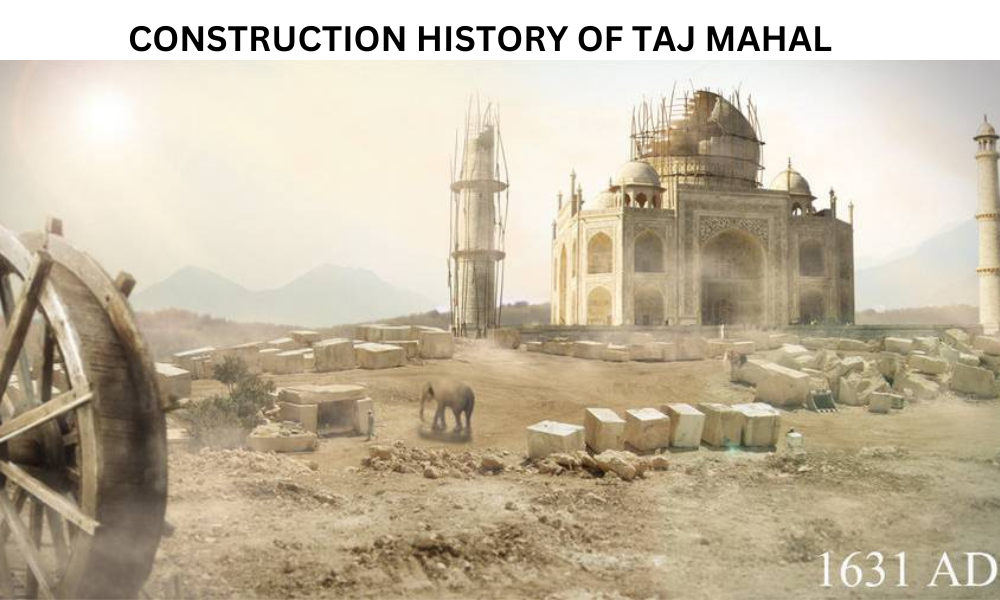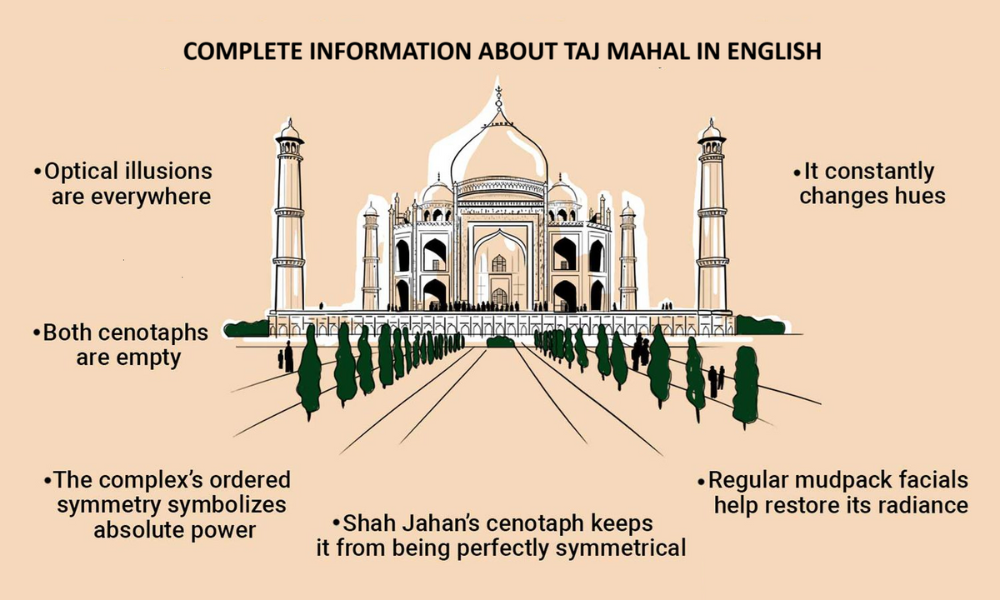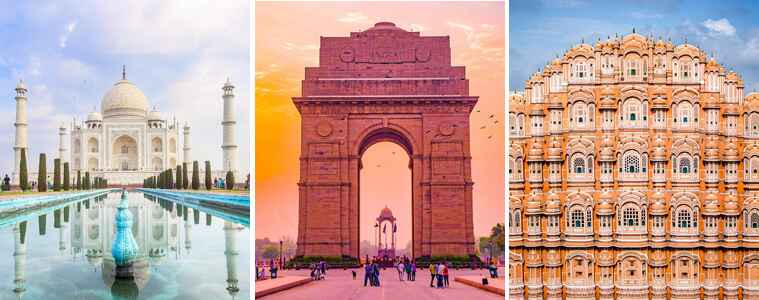The world-famous Taj Mahal is a beautiful monument and also one of the Seven Wonders of the World. This is an astonishing architectural piece that is an expression of never-ending love. The Taj Mahal is situated in Agra, at the river band of Yamuna, India. Every year, millions of tourists visit this marvellous destination piece of the world. But do you know about the interesting story behind the inspiration and construction of Taj Mahal? If no!! Then do not worry; you have reached the right place. Here we are sharing complete information about Taj Mahal history in English that covers its history, architecture, and what you should know before planning your visit.
Taj Mahal History In English : The Ultimate Love Story
The Taj Mahal is made of white marble on the banks of the Yamuna River in the city of Agra, Uttar Pradesh. This white marble monument was built in 1653 by the hard work of 20,000 labourers for about 22 years. Perhaps The Taj Mahal is a tale of love and loss. It was built by Emperor Shah Jahan in memory of his beloved wife, Mumtaz Mahal, who died in 1631.
Shah Jahan, the son of Mugal Emperor Jahangeer, had married the Persian princess Mumtaj at the age of 14. Shah Jahan had many wives, but he loved Mumtaj the most, who was the most beautiful and charming. But in 1632, Mumtaj passed away while giving birth to their 14th child. And to fulfil the last wish of Mumtaj, Shah Jahan decided to build this world-famous monument.
The Taj Mahal was built between 1632 and 1653. It took 21 years to complete and employed thousands of artisans and craftsmen from India, Persia, and the Ottoman Empire. The Taj Mahal is one of the most beautiful monuments in the world, synonymous with the love that existed in eternity for Shah Jahan.
Details About Taj Mahal History in English:
But this architecture, which is called a symbol of love all over the world, is as luxurious as it is wretched. Also, because buried beneath it is the story of the blood, sweat, and starvation of millions of workers. It tells how a debauched king Shah Jahan, in his indulgence and lust of his queen Mumtaj, made India completely bankrupt, and after that, Shah Jahan’s own son Aurangzeb took power by killing his father and his brothers.
However, that is not the end of the Taj Mahal story. Let us now explore what was happening in India during British rule.
Further into history, in 1908, Viceroy Lord Curzon initiated a restoration process. At this time, soldiers were sent to extract the precious and semi-precious stones bonded in the walls of the Taj Mahal. The original gardens surrounding the monument that you see today were redesigned in the British style. During the Indo-Pak war in 1941, the Taj was protected under scaffolding from its shine and brilliance.
Complete Information Of Construction and Details About Taj Mahal History in English:
Just like the history of Tajmahal, the construction of this beautiful marble has its own secrets. Let’s discuss complete details about Taj Mahal history in English. So do you ever think that this marvellous architecture could have been built at that time without cement?? How do labourers connect the marble with each other?? As cement was invented in England by a scientist named Joseph Aspdin in 1824 AD, then how could this monument be made??
So this wonder was done by the intelligence of ancient architects, as they made this special kind of solution using clay soil, jaggery, batasha, Belgiri water, urad dal, curd, jute, and pebbles. This special kind of solution was prepared by mixing gum, etc. and was used in the foundation of the building. This is the reason that even after so many years, Taj Mahal is so strong that it can easily withstand earthquakes, storms, rain, sunlight, heat, and cold.
As the same, the wood that is used in the foundation of the Taj Mahal is a special kind of wood that becomes stronger when it gets moisture from water and does not get spoilt by water. In fact, the minds of the engineers of that time were unmatched in themselves.

Construction History Details of Taj Mahal in English:
Shah Jahan gave the responsibility of building the Taj Mahal to the best architect of his time, Ustad Ahmed Lahauri. The white marble of the Taj Mahal was imported from Makrana, Rajasthan, and the credit for the beautiful handicraft done on the white marble goes to Abdul Haq Shirazi. You will be surprised to know that whatever material was brought to build the Taj Mahal, more than 10,000 elephants and camels were used in it. Along with this, many precious gems were also used to decorate the Taj Mahal, such as jasper, jade, and crystal China from Punjab. 28 precious gems like turquoise from Tibet, sapphire from Sri Lanka, and carnelian from Arabia were used, but during British rule, the Persians took out all these gems from the Taj Mahal.
Despite the pollution and acid rain over the years, the Taj Mahal has miraculously maintained its whiteness and grace just as it was hundreds of years ago. This tourist marvel continues to stand as an enigmatic monument for beauty and elegance, celebrating the undying power of true love. Thus, we bring our journey through the details of Taj Mahal history in English to a close.
Information About Taj Mahal History in English: Architectural Wonder
The architecture of Taj Mahal integrates one-of-a-kind elements from Islamic, Persian, Ottoman Turkish, and Indian styles. Indeed, it is a wonder with its own unique blend of style. Let’s know more information regarding Taj Mahal history in English.
- Material: The primary material used to construct the Taj Mahal is white marble that came directly from Makrana, Rajasthan.
- Main Building: Very large, white marble mausoleum, topped by a central dome, and topped by four smaller domes.
- Minarets: The four minarets surrounding the main building are of the same height, each 40 meters high.
- Decorative Elements: Walls studded with precious stones, inlay work, and fascinating carvings.
- Garden Layout: The garden has been planned as an extensive Mughal garden with lots of fountains and reflecting pools.
The symmetry, carvings, and perfect proportions are so alluring. So it becomes a must-visit place for every architecture or history buff.
Quick Facts: Complete Information About Taj Mahal History in English
- Built by: Emperor Shah Jahan
- Construction started in: 1631
- Completed in: 1653
- Architectural Style: Mughal (combination of Indian, Persian, and Ottoman styles)
- Main Materials Used: White marble, red sandstone, precious stones
- Location: Agra, Uttar Pradesh, India








